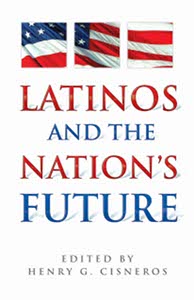Whether the predominant ethnic group in baseball, the swing vote in various elections, or the people who introduced one of the countrys most popular condiments, salsa, it is clear that the influence of Latinos is widespread and growing each year. The Census Bureau estimates that Latinos will grow by 63 million peopleor a stunning 48% of total growthto make up 25% of the United States population by 2050. Editor Henry G. Cisneros, the first Hispanic mayor of a major U.S. city and former HUD Secretary, says these numbers are not reversible by closing borders, they are the simple demographic trajectory of people already living in the U.S.
In his chapter that opens this landmark collection of essays about the future of the U.S., Cisneros asserts that the country cannot continue its historic path of growth, progress, and greatness without substantial improvements in the Latino communitys economic and educational status. The fate of the nation is inextricably linked to that of the Hispanic community not only because of its size, but also because of its relative youthfulness as other populations grow older and leave the workforce. There is absolutely no doubt that the success and well-being of Latinosor lack thereofwill impact the country as a whole.
The outgrowth of a conference involving Latino leaders and exploring the impact of the dynamic growth of the Hispanic population in the U.S., Latinos and the Nations Future contains essays by leading scholars, civil rights leaders and other professionals on issues impacting the advancement of Latino citizensand therefore, all U.S. citizens.
- Cover
- Title page
- Copyright page
- Dedication
- Contents
- Foreword. Janet Muruguía
- By way of introduction and acknowledgment. Henry G. Cisneros ; John Rosales
- Part One. Latino Visions: Past, Present, and Future
- One. An overview latins and the nation's future. Henry G. Cisneros
- The scale of the latino presence
- Latino youthfulness as an american asset
- Latino acceptance of responasbility for a decisive part in the American future
- A national commitment to invest in the next generation of Americans
- The American idea and Latino integration
- Two. The latino presence: Some historical background. Nicolás Kanellos
- Labor - The dominant force in U.S. Latino society
- Transforming mainstream culture
- Three. Liberty and justice for all: Civil rights in the years ahead. Raúl Yzaguirre
- Four. Becoming american - The latino way. Tamar Jacoby
- The subjective side of Americanization
- Absorption - Language as the first giant step
- Part Two. Latinos and the Larger Society
- Five. Increasing hispanic mobility into the middle class: an overview. Harry P. Pachon
- The current dilema of American's middle class
- The complexity of the hispanic community
- Journey to the middle class
- Budgeting for education: crucial resources
- Latino asset development and asset protection
- In conclusion
- Six. Latino small business: A big present, a bigger future. Aída M. Álvarez
- Small business is big business
- The U.S. hispanic small business economy
- Starting small
- Small business owners Vs Entrepreneurs
- Shifting the mindset
- Tracking growth
- Latina entrepreneurs: a driving force
- Make mine a million $ business
- The last meritocracy
- A national Latino small business agenda
- An agenda for micro-business
- An agenda for strengthening Latino-owned business
- An agenda for growing Latino-owned business
- Seven. Making the next generation our greatest resource. Sarita E. Brown
- Making the case for investing in education
- Current conditions: unacceptable
- Absence of Latinos in higher education is a national liability
- Hope amid obstacles: a snapshot of Latino trends
- Raising the bar for hispanic-serving institutions
- Strong leadership can set progress in motion
- Making it personal
- Taking steps to promote college succes
- It's time to end the "Pothole" approach to fixing higher education
- A plan for action; a time to act
- Eight. La gran oportunidad / Up for grabs / The hispanic opportunity. Joe García
- Nine. Politics and the latino future: A republican dream. Lionel Sosa
- Ten. Latino progress and U.S. foreign policy. Sergio Muñoz Bata
- The purpose of the essay
- A short story on ethnic lobbies in the United States
- Latinos and U.S. foreign policy
- The mexican diaspora and its relationship with Mexico
- U.S. foreign policy and the changing face of the Latino community
- The myth of dual loyalty
- Latinos and immigration
- Could Latinos make a difference in the formulation of U.S. foreign policy, twnty-five years from today?
- Forecasting a U.S. foreign policy agenda
- Conclusions
- The border as a meeting place
- Part Three. Raw numbers and their impact
- Eleven. The raw numbers: Population projections and the power of hispanic demographic change. Leobardo F. Estrada
- Twelve. Latino numbers and social trends: Implications for the future. Roberto Suro
- In the aftermath of the marches
- Language and attitudes
- Looking to the future
- Thirteen. A first-order need: improving the health of the nation's latinos. Elena V. Rios
- Female, 49, no insurance
- Male, 41, limited HMO coverage
- High School student, 16, obese
- The socioeconomic and health profile of Latinos
- Strategies to eliminate health disparities
- Cultural competence
- A time for action
- Improving our own wellness
- Conclusion
- Fourteen. Housing the nation's latinos: an overview. Saúl N. Ramírez, Jr
- Latinos and the hime ownership and rental markets
- Education and financial literacy
- Access to financial services
- The government and the grassroots
- Some thoughts concerning latino living space
- The importance of integration
- Conclusion
- Part Four. Final Thoughts
- Fifteen. On the power of education and community action. Ernesto Cortés
- Sixteen. Toward a new american dream. Nicolás Kanellos
- Appendices
- Appendix I. Tables, charts, and maps
- Appendix II. Chapter notes and bibliography

